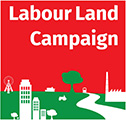LVT will lead to a more efficient use of land

- LVT is levied on the value of land according to its permitted use, irrespective of how it is currently being utilised. If it is underutilised or lying derelict, there will be every incentive to invest capital to make better use of the land to generate income, and thus reduce the burden of LVT, or to sell the land to someone who is prepared to invest that capital.
- LVT would eliminate speculation in land. It would make no economic sense to leave land idle in the expectation that it might fetch a higher price in due course, because, unlike now, the tax would still have to be paid.
- Businesses and home seekers will be encouraged to relocate to areas where land values are low for whatever reason, thus helping to develop or regenerate those areas by making better use of the land.
LVT will lead to an improved environment

- LVT will bring about the rejuvenation of land occupied by derelict buildings and so-called brownfield sites in towns, because the landowner would have to pay LVT on the land according to its permitted use anyway. Therefore, as just noted, he or she would have the incentive to invest capital in the land, to make full use of it, subject to planning regulations, or to sell it to someone who will.
- By encouraging the use of brownfield sites for housing and commercial activities, LVT will help reduce urban sprawl and the need to encroach on green land.
- By encouraging less urban sprawl through the more efficient use of land in towns, LVT will help to reduce long distance commuting, particularly by car, and less will have to be spent on roads and on public transport, thus saving on energy and reducing atmospheric pollution.
- Because of its major positive impact on the environment, therefore, LVT, in effect, will act as a green tax.
- Meanwhile, planning regulations would preserve green spaces and other uses of land for public benefit. In addition, because, as noted below, LVT will lower the price of land over time, local authorities and other agencies could more easily acquire land to add to green spaces, protect wildlife, create parks and provide for recreational use – which would be encouraged by the fact that this would add to the value of neighbouring sites, and therefore increase revenue from LVT.
- Finally, as observed in towns in the United States operating a system of LVT, by ridding communities of derelict sites and buildings, and increasing job opportunities (see next item), LVT will help to eliminate vandalism and anti-social behaviour.
LVT will help promote more sustainable economic development

- Shifting the tax burden increasingly onto LVT will stimulate investment and employment, and therefore economic development. First, it will allow those taxes that act as a disincentive for investment and employment to be reduced or eliminated. As implied above, most other taxes, including taxes on incomes and capital, and on consumption, have a negative impact on economic development, because they increase the costs of investment and employment.
- When these taxes are higher, it means that employers have to pay workers more to compensate for the higher taxes workers have to pay, and at the same time the market for goods and services is reduced. This would be offset to an extent by government spending on public services, which would create jobs and generate economic demand, thus stimulating investment and employment in the production and supply of goods and services to meet that demand. Substituting LVT for those other taxes would encourage this process all the more.
- Second, the more LVT that owners of land have to pay, the more incentive they will have to invest capital in order to make the most efficient use of the land. This would help create more industries or services, and therefore more jobs, or more homes, depending on what the land is used for (subject to planning permission), which is what economic development is about.
- Furthermore, depending on the rate of tax, LVT will tend to lower the market price for land, first, because potential buyers would take into account the LVT that they would have to pay in the future as a result of owning the land, and second, because owners of derelict sites and property developers holding ‘land banks’ (often for speculative purposes), who would become liable for LVT, would have the incentive to bring the land into use as quickly as possible, which would increase the supply of land.
- However, this tendency for land prices to be lower would be offset by rising economic activity (partly due to the introduction of LVT, as such, and partly due to the concomitant reduction of other taxes that have an adverse impact on economic development). This would tend to increase the demand for land and therefore its value – but less so its price because more of the higher land value would go to the community in the form of LVT.
- The net effect, over time, therefore, would be for land prices to be lower than they would otherwise be, and less subject to inflation. This would mean that less capital would be needed to acquire land, leaving more available for investments on the land, such as affordable housing or some other productive activity, thus creating jobs and enhancing the process of economic development.
- Meanwhile, the more that LVT encourages investment in new productive activities, the more this will increase the demand for land, and therefore its value, allowing more revenue to be collected from LVT. This could be used to improve public services, or allow other taxes to be reduced further, which would act as a further incentive for others to invest. Either way, or in combination, it would expand economic activity and job opportunities, with the cycle capable of being repeated over and again. In short, LVT would help promote more sustainable economic development.
Read more of our ‘Manifesto’:
Introduction
Fair
A green tax
Transport
Housing
Farming
The difference
Clear and simple
Implementing
